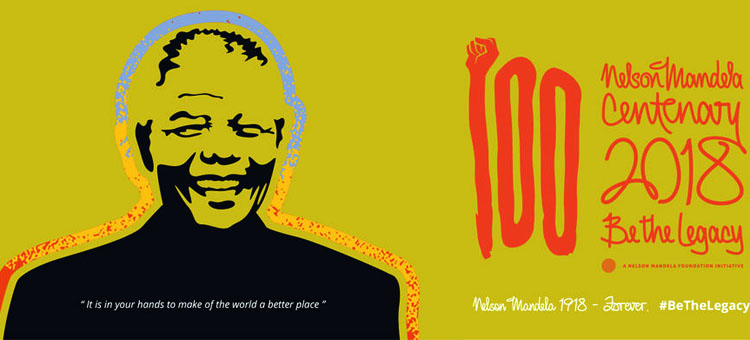Mumbai: July 8, also known globally as Mandela Day, marks the passage of a century since the birth of the great South African revolutionary, Nelson Mandela. The Nelson Mandela Foundation will mark this year by investing their efforts in building a values-based society by a host of programs and initiatives.
South African government also launched a set of limited edition bank notes and gold coins to mark the 100th anniversary of the birth of the late President Nelson Mandela. The launch forms part of events across the world, culminating locally in an annual Mandela Day lecture by former US President Barack Obama.
With Barack Obama setting the tone for this year’s celebration, 2018 will also be iconic in bringing together the crème da le crème of the world to celebrate the legacy of Madiba. Among the many ways in which the learnings and memories of Madiba are being brought alive, the most anticipated is the Global Citizen Festival, which will be headlined by celebrity couple Beyoncé and Jay-Z.
Scheduled to take place in Johannesburg in December, Global Citizen Festival will see popular celebrities play their part in paying homage to Nelson Mandela and alleviate extreme poverty. In what would be “the greatest that Global Citizen had ever put together” as described by the Global Citizen CEO, Hugh Evans, the festival will see performances by artists like Cassper Nyovest, D’banj, Ed Sheeran, Eddie Vedder, Femi Kuti, Pharrell Williams, Chris Martin, Sho Madjozi, Tiwa Savage, Usher, and Wizkid.
The festival’s hosts include Naomi Campbell, Sir Bob Geldof, Gayle King, Bonang Matheba, Tyler Perry, and Forest Whitaker.The who’s who of the world coming together only bears testament to the fact that by any measure, Nelson Mandela’s impact, both locally and globally, has been unparalleled.
Many places in the Rainbow Nation commemorate the birth of the revolutionary. From the rolling hills and scattered villages of Qunu in the Eastern Cape, to reverent reflections in the prison cells of Robben Island, to the sacred sidewalk on Vilakazi Street in Soweto – South Africa offers a chance to follow in the footsteps to freedom of the nation’s most iconic hero – Nelson Rolihlahla Mandela.
Robben Island
Nelson Mandela spent 18 immensely challenging years in prison on this little island situated off the coast of Cape Town and yet emerged from it filled with forgiveness instead of hatred. Robben Island is now a World Heritage site and museum. Although from the 17th to the 20th century the island was a place of imprisonment – today it is a beacon of hope and a place where visitors can gain some insight into the life and times of Nelson Mandela and fellow freedom fighters. Trips to Robben Island begin from the Nelson Mandela Gateway at the V&A Waterfront, where ferries transfer you to the former prison.
Constitution Hill
Through the years, the Constitution Hill functioned mainly as a prison. It was here that many passive resistors and freedom fighters including the Father of our Nation – Mahatma Gandhi, and Nelson Mandela were held; the site has two permanent exhibitions that revolve around the lives of both these revolutionaries. A walk through Number Four section of the prison, reading up on the horrific conditions of the time and the difference in how prisoners of different races were treated, quickly hammers home the need for radical reform and equality for which Mandela was fighting – and ultimately achieved. The Constitution Hill in Johannesburg is now a fascinating museum and the home to South Africa’s constitutional court.
Apartheid Museum
Apartheid – a system of institutionalized racial segregation and discrimination, had infiltrated every nerve of the country. These dogmas (or the resistance towards them) helped shape Mandela’s entire life and nowhere can you get a better grip on what transpired during the proceeding struggle than at the Apartheid Museum, situated south of Johannesburg. The Apartheid Museum opened in 2001 and is acknowledged throughout the world for its illustrious display of the rise and fall of Apartheid. Allow yourself at least a couple of hours to soak it all in, and get over an emotional yet interactive and informative visit.
Capture Site
This site has enormous significance in the history of the freedom struggle because it was here that, after 17 months if evading the apartheid authorities, Nelson Mandela was arrested. On August 5, 1962, the policed flagged down a car driven by Nelson Mandela in a chauffer’s uniform while he was returning from a secret meeting with the African National Congress president – this incident would go on to shape the future of an entire country. To mark the historic spot is a sculpture comprising of 50 steel rods, that align to create a magnificent portrait of Mandela.
Mandela House
Situated in Vilakazi Street, the humble home Mandela moved into in 1946, the Mandela House gives visitors great insight into the Mandela family.“It was the opposite of grand,” he wrote in his autobiography, Long Walk to Freedom, “but it was my first true home of my own and I was mightily proud.” The house is filled with memorabilia about the family, complete with photographs and visuals and is a fitting tribute to the incredible struggle for freedom. Vilakazi Street is usually flooded with visitors wanting a glimpse into the home of the great Madiba – hence getting an early start to this place might be a good idea.





